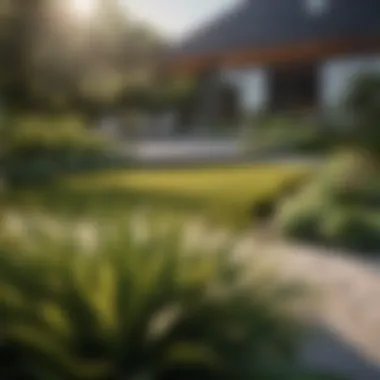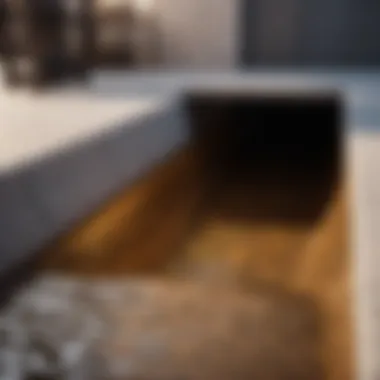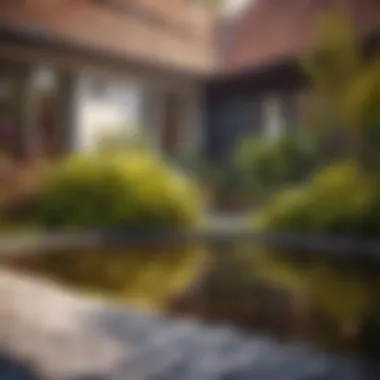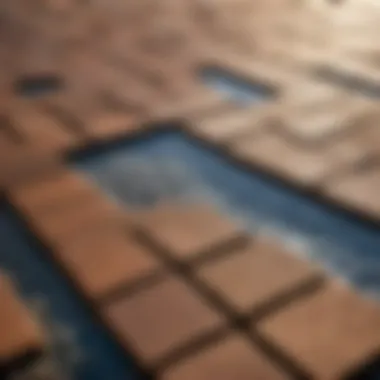Ultimate Guide for Improving Drainage Around Your Home to Prevent Water Damage and Maintain Property Integrity


Materials:
- Landscaping fabric - 100 square feet
- Gravel - 3 cubic yards
- Perforated drain pipe - 100 feet
- Drainage fittings - 10 pieces
- Shovel - 1
- Wheelbarrow - 1
- Tape measure - 1
- Work gloves - 1 pair
- Safety goggles - 1 pair
DIY Steps:
- Preparation
- Start by measuring the area around your house where drainage improvement is needed.
- Clear the area of any debris or vegetation that may obstruct the installation process.
- Landscaping Fabric Installation
- Lay the landscaping fabric over the prepared area, ensuring it covers the entire space.
- Secure the fabric in place using landscape staples to prevent shifting.
- Drain Pipe Installation
- Dig a trench along the perimeter of the house, sloping it away from the foundation.
- Place the perforated drain pipe in the trench, ensuring it has a downward slope for proper water flow.
- Gravel Backfilling
- Fill the trench with gravel to cover the drain pipe completely.
- Compact the gravel using the back of a shovel to provide stability.
- Connection of Drainage Fittings
- Connect the drainage fittings to the end of the drain pipe to redirect water efficiently.
- Test the system by pouring water into the trench to check for proper drainage.
Technical Aspects:
- Tools: Ensure you have a shovel for digging, a wheelbarrow for transporting materials, and safety equipment such as work gloves and goggles.
- Timing Specifics: Allocate a full day for completing the drainage enhancement project to ensure proper installation.
- Critical Techniques: Focus on maintaining a consistent slope in the trench for effective water drainage.
DIY Project Process:


- Detailed Installation Method:
- Follow the step-by-step guide for installing the landscaping fabric and drain pipe around your house.
- Pay attention to the slope of the trench and ensure proper backfilling with gravel.
- Highlighting Key Techniques and Timings:
- Emphasize the importance of compacting the gravel and testing the drainage system for functionality.
- Troubleshooting Tips:
- If the water is not draining properly, check for clogs in the drain pipe or inadequate slope in the trench.
- Adjust the position of the drainage fittings if water flow is not directed away from the house effectively.
Understanding Drainage Issues


Understanding drainage issues is paramount when it comes to safeguarding your property against potential water damage. This section delves into the crucial aspects of drainage problems that homeowners may encounter, emphasizing the need for a proactive approach to mitigate risks and maintain the structural integrity of your house.
Importance of Proper Drainage
Proper drainage plays a pivotal role in preserving the stability and longevity of your property. By ensuring efficient water flow away from your home, you can prevent a myriad of issues that may arise due to stagnant water accumulation. Within the context of this comprehensive guide, the key elements of proper drainage are highlighted to underscore its significance.
Preventing Foundation Damage
One of the primary concerns addressed by adequate drainage is the prevention of foundation damage. Foundation damage can have far-reaching consequences, impacting the entire structure of your house. By implementing strategies to divert excess water away from the foundation, you can safeguard against costly repairs and structural compromise. The meticulous planning of grading, landscaping features, and drainage systems are crucial in mitigating the risks associated with foundation damage.
Avoiding Basement Flooding
Basement flooding is a nightmare for any homeowner, often leading to extensive property damage and mold issues. An effective drainage system is instrumental in avoiding basement flooding, channeling rainwater and surface runoff away from vulnerable areas. By incorporating proper grading and installing suitable drainage solutions, you can significantly reduce the likelihood of basement inundation, ensuring a dry and secure living environment.
Enhancing Landscape Health
In addition to protecting your home's structural integrity, proper drainage also contributes to enhancing landscape health. Excess water retention can adversely affect plant life, causing root rot, soil erosion, and nutrient leaching. By facilitating adequate water drainage through well-planned landscaping features and drainage mechanisms, you can promote the thriving growth of vegetation and maintain the visual appeal of your outdoor spaces.
Common Causes of Poor Drainage
Identifying the common causes of poor drainage is essential in proactively addressing potential water management challenges around your property. By recognizing the factors that contribute to inadequate drainage, you can implement targeted solutions to rectify these issues effectively.
Improper Grading
Improper grading is a prevalent cause of poor drainage, often resulting in water pooling near the foundation of the house. Improving the slope and elevation of the landscape is pivotal in directing water away from vulnerable areas, ensuring proper drainage and minimizing the risks of water-related damage. Proper grading techniques tailored to your property's specific topography are crucial for effective water flow management.
Surface Water Runoff
Surface water runoff poses a significant threat to drainage efficiency, especially in areas prone to heavy rainfall or storms. The swift diversion of rainwater away from impermeable surfaces is imperative in preventing water accumulation and subsequent flooding. Implementing strategies such as permeable pavements, rain gardens, and proper drainage infrastructure can mitigate the impact of surface water runoff, enhancing overall drainage performance.
Clogged Gutters
Clogged gutters are a common culprit behind drainage issues, impeding the smooth flow of water from the roof to the ground. Debris buildup in gutters can lead to water overflow, causing water infiltration into the interior spaces of your home. Regular gutter cleaning and maintenance are essential practices to ensure unobstructed water flow and prevent potential water damage. Effective gutter systems play a critical role in directing rainwater away from the house, safeguarding against issues related to poor drainage.
Assessing Drainage Needs


Improving drainage around your house starts with a crucial step - assessing your drainage needs. Understanding the specific requirements of your property ensures effective water management to avoid potential water damage issues. By evaluating the drainage needs, you can proactively address any existing problems and prevent future complications.
Site Evaluation
Identifying Water Accumulation Areas
When it comes to site evaluation, identifying water accumulation areas plays a vital role in determining potential trouble spots. By pinpointing where water tends to pool or accumulate on your property, you can strategize the placement of drainage solutions effectively. Recognizing these areas allows you to tailor your drainage approach to address them specifically, enhancing the overall effectiveness of your drainage system.
Examining Slope and Soil Composition
Another critical aspect of site evaluation is examining the slope and soil composition of your property. The slope dictates how water flows across your land, influencing drainage needs significantly. Likewise, soil composition impacts water absorption rates, which are crucial for determining the most suitable drainage solutions. Understanding these factors helps in selecting the appropriate methods to optimize water flow and prevent pooling on your property.
Determining Drainage Solutions
Surface Drainage Options
Surface drainage options offer visible solutions for managing water around your home. These solutions, such as grading, swales, or permeable surfaces, direct water away from structures to prevent water damage. Surface drainage options are popular for their ease of installation and effectiveness in controlling surface runoff without extensive excavation.
Subsurface Drainage Solutions
In contrast, subsurface drainage solutions address water issues below the ground surface. Systems like French drains or dry wells collect excess water from the ground and redirect it away from your property. Subsurface drainage solutions are beneficial for properties with high water tables or frequent flooding, providing discreet and efficient water management.
Implementing Effective Drainage Techniques
In this comprehensive guide to enhancing drainage around your house, Implementing Effective Drainage Techniques plays a pivotal role in safeguarding your property from water damage and maintaining its structural integrity. By focusing on effective drainage techniques, you're taking proactive steps to manage excess water efficiently. It is essential to understand the specific elements and benefits of Implementing Effective Drainage Techniques to address drainage issues properly. Considerations like proper planning, suitable drainage solutions, and periodic maintenance are vital aspects when implementing these techniques.
Landscaping Strategies
Planting Water-Absorbing Vegetation
Planting Water-Absorbing Vegetation is a critical aspect of landscaping strategies to enhance drainage around your house. This specific technique involves selecting plants with high water absorption capabilities to help manage excess water effectively. The key characteristic of Planting Water-Absorbing Vegetation is its ability to reduce water runoff and prevent soil erosion, making it a popular choice for this article. The unique feature of this strategy is its contribution to improving soil health and preventing waterlogging, which are advantageous for maintaining a balanced moisture level around your property.
Creating Swales and Berms
Creating Swales and Berms is another essential landscaping strategy that significantly contributes to effective drainage. This technique involves shaping the land to create shallow ditches (swales) and raised mounds (berms) to redirect water flow away from vulnerable areas. The key characteristic of Swales and Berms is their efficiency in slowing down and infiltrating water, reducing erosion and enhancing water absorption. This method is a beneficial choice for this article due to its ability to manage surface water effectively and reduce the risk of flooding. The unique feature of Swales and Berms lies in their natural approach to improving drainage without the need for complex infrastructure, offering a sustainable solution for your property.
Installing Drainage Systems
French Drains
French Drains are a fundamental aspect of installing drainage systems to improve water management around your house. This specific drainage system consists of a trench filled with gravel and a perforated pipe to redirect groundwater away from your property. The key characteristic of French Drains is their versatility in handling different soil types and water volumes, making them a popular choice for diverse drainage needs. The unique feature of French Drains is their ability to effectively prevent surface and groundwater from pooling around your property, thus safeguarding your foundation and basement from water damage.
Dry Wells
Incorporating Dry Wells into your drainage system is essential for managing excess water efficiently. Dry Wells consist of underground storage containers that collect and slowly disperse excess water into the ground, reducing runoff and erosion. The key characteristic of Dry Wells is their capacity to store significant water volumes while allowing gradual infiltration into the soil, making them a beneficial choice for areas with high water flow. The unique feature of Dry Wells lies in their ability to enhance groundwater recharge and reduce the strain on municipal drainage systems, offering ecological benefits for your property.
Channel Drains
Channel Drains are crucial components of drainage systems designed to redirect surface water away from your house. These linear drains are typically installed along driveways, patios, or walkways to channel rainwater towards designated drainage points. The key characteristic of Channel Drains is their efficiency in quickly removing water from surfaces, preventing water accumulation and potential flooding. This system is a popular choice for this article due to its versatility in managing different types of surface water runoff effectively. The unique feature of Channel Drains is their durability and ease of maintenance, providing a reliable solution for enhancing drainage around your property.
Maintaining Drainage Infrastructure
Clearing Debris Regularly
Regularly clearing debris from your drainage infrastructure is a crucial maintenance aspect to ensure optimal functionality. This practice involves removing leaves, twigs, and other obstructive materials from gutters, grates, and drain openings to prevent blockages and maintain smooth water flow. The key characteristic of Clearing Debris Regularly is its preventive nature, which helps prevent clogs and potential water backups that can lead to water damage. It is a beneficial choice for this article as it promotes the longevity and efficiency of your drainage system. The unique feature of regularly clearing debris is its cost-effective and straightforward approach to preserving proper drainage, providing peace of mind for homeowners.
Inspecting for Blockages
Regularly inspecting your drainage system for blockages is an essential maintenance practice to identify and address potential issues promptly. This involves visually inspecting pipes, drains, and outlets for any signs of blockages or obstructions that could impede water flow. The key characteristic of Inspecting for Blockages is its proactive approach to preventing water damage by detecting and resolving drainage problems early on. This practice is a popular choice for this article as it helps maintain the effectiveness of your drainage infrastructure. The unique feature of inspecting for blockages is its ability to ensure continuous water flow and mitigate the risk of costly repairs, offering a proactive maintenance solution for homeowners.
Seeking Professional Assistance
Seeking professional assistance is a crucial aspect of enhancing drainage around your house. When it comes to implementing effective drainage solutions, consulting with experts can greatly benefit homeowners. By enlisting the services of professionals, you ensure the proper evaluation, planning, and execution of drainage systems tailored to your specific property needs. Professional assistance can save you time, money, and potential infrastructure damage in the long run. They provide expertise in identifying optimal solutions, managing complex projects, and ensuring compliance with local regulations.
Hiring Drainage Experts
Consulting with Landscaping Professionals
Consulting with landscaping professionals plays a vital role in the successful implementation of drainage systems. These experts specialize in landscape design and can offer valuable insights into integrating drainage solutions seamlessly with your outdoor aesthetics. They bring expertise in grading, planting water-absorbing vegetation, and creating functional landscapes that enhance drainage efficiency. By collaborating with landscaping professionals, homeowners can achieve a harmonious balance between functionality and visual appeal, ensuring a well-rounded approach to drainage improvement.
Engaging Civil Engineers
Engaging civil engineers is another essential aspect of seeking professional assistance for drainage enhancement. Civil engineers possess the technical knowledge and expertise required to design and implement complex drainage systems. They can conduct in-depth site evaluations, provide detailed drainage plans, and oversee the construction process to ensure optimal performance. Civil engineers bring a scientific approach to drainage projects, considering factors such as soil composition, water flow dynamics, and structural integrity. Their involvement guarantees a robust and sustainable drainage infrastructure that meets both functional and regulatory standards.
Obtaining Permits and Approvals
Complying with Local Regulations
Complying with local regulations is a fundamental requirement when enhancing drainage around your property. Obtaining necessary permits and approvals ensures that your drainage solutions are in accordance with municipal guidelines and environmental standards. By adhering to local regulations, homeowners mitigate legal risks, prevent potential fines, and promote responsible land management practices. Compliance with regulations also fosters community well-being by mitigating potential drainage-related issues that could impact neighboring properties.
Ensuring Proper Documentation
Ensuring proper documentation is an essential step in the permit acquisition process for drainage projects. Keeping detailed records of design plans, material specifications, and construction progress facilitates a smooth approval process and reduces delays. Proper documentation not only streamlines the permitting procedure but also serves as a valuable reference throughout the project lifecycle. By maintaining organized documentation, homeowners can track project milestones, address concerns effectively, and ensure transparency in their drainage improvement endeavors.



